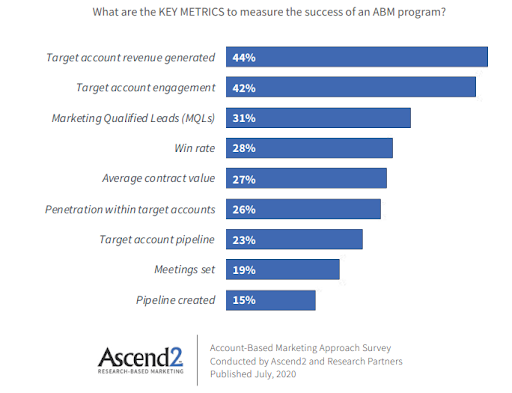Filters
Content Type
Topic
6 Account-Based Marketing Challenges (+ Solutions)
Account-based marketing (ABM) allows B2B marketers and sales professionals to target key accounts and drive revenue. However, there are a few challenges that come with implementing an ABM strategy. From lack of data to inefficient processes, B2B teams need to be aware of the hurdles they could face when launching an ABM campaign.
In this post, we’ll discuss the most common account-based marketing challenges and offer solutions to help you overcome them.

1. Aligning Your Sales and Marketing Teams
Account-based marketing is most known as a strategic approach to B2B marketing that involves aligning your sales and marketing teams in an effort to improve the quality of leads and increase the likelihood of them converting into customers.
Statistics back this assertion, with 72% of sales and marketing leaders agreeing that having a strong alignment between sales and marketing positively impacts overall performance. The proof is in the pudding, and the more aligned your sales and marketing teams are, the better the quality of leads and the greater the ROI:
- Aligning sales and marketing teams can help generate 209% more revenue from marketing efforts (Marketo)
- Aligning your teams could lead to 38% higher sales win rates (MarketingPros)
- Alignment between teams can help you become 67% better at closing deals (Marketo)
Solution: Get Them Working Together from the Start
To reap the rewards of alignment, you need to get started. Whether you’re a new organization or already established, the first step in aligning your teams is to get them working together. The sooner you get the two teams in the same room and brainstorm together, the sooner they can start co-building a strategy that will outline shared goals and objectives and methods of achieving them.
2. Building the Perfect ABM Tech Stack
One common problem that newly adopted account-based marketing (ABM) strategies face is the need for the right tools to help them execute their strategy. Quite a bit of technology goes into executing ABM successfully, which can be overwhelming for any organization. Not only can it be costly upfront, but it also requires a significant amount of ongoing training and support to ensure that the technology is being used correctly and to its fullest potential.
Solution: Start with the Basics and Add On As Needed
The good news is that you don’t need a complicated tech stack to execute an ABM strategy. In fact, even as your business grows, your ABM tech stack should only grow as needed. A few must-haves you’ll want to include are:
- A CRM tool to keep all your contacts organized and easily accessible
- A demand gen tool to help identify accounts for you
- Lead nurturing tools to help deliver personalized content and encourage engagement
- Automated retargeting tools to help you follow up with leads
- An automated data capture and analysis tool
- Website personalization tools to help you create a unique experience for each visitor, such as dynamic landing pages
3. Knowing Who to Target
Account-based marketing is all about targeting the right accounts at the most opportune moment. It’s a fine line to walk. For more well-established companies, you may already have an extensive database of existing customers and potential customers that can be used as a foundation for your ABM strategy. But for those who don’t have a well-defined target audience, it can be difficult to identify the right accounts.
Solution: Start With Your Existing Customer Base
To find out who your target audience is, sit down with both your marketing and sales teams (again, why alignment is so important!) and discuss who seems to be actively engaging with your brand and who seems to be falling off. Once you have a clear idea of who your current customers are, you can work on developing a strategy to target similar accounts.
4. Determining the Ideal Budget for ABM
Determining the perfect budget for ABM adaptation and deployment can be challenging. That’s because there are several factors to consider when choosing how much you can spend and how to determine the ROI on ABM. If you’re looking for a clear-cut answer, one Forrester study showed that the average ABM budget in 2021 was roughly $590,000 (not including headcount costs).
Solution: Evaluate Your Current Cost Structure
Evaluating your current cost structure can help you determine an ideal budget for your account-based marketing efforts. By understanding your existing cost structure, you can identify areas that are inefficient and need improvement, as well as areas that are over budget and can be reduced.
Additionally, you can use this information to better understand your available budget for your ABM efforts and how much you should spend on each account. This will help you create a realistic and achievable budget and maximize ROI on your ABM efforts.
5. Determining How to Measure the Success of Your ABM
Determining a budget for ABM can be a challenge because there’s no single method to measure ABM’s success. Determining the ROI of your ABM efforts is difficult but possible. It will just depend on which metrics you choose to use.
Solution: Transfer Your Attention Away from Vanity Metrics to the Metrics that Matter
When determining which metrics to track, you really want to move your attention away from vanity metrics such as page views, clicks, and social media likes or shares. These metrics can be useful when determining your ideal audience and their interests, but they’re less effective when determining how successful your ABM campaigns have been.
Instead, you’ll want to focus on more tangible metrics, like:
- Marketing qualified leads (MQLs)
- Penetration within target accounts
- Pipelines created
- Target account engagement
- Target account revenue generated

Source: Ascend2 via Convince and Convert
6. Figuring Out How to Personalize Your Content Without Burning Out
Content creation is a labor-intensive process, and many marketers struggle to keep up with the sheer volume of content they need to create to keep up with the demands of their audience.
When adopting an ABM strategy, the goal with content is to create account-focused materials that address the needs of each specific account. But there are only so many hours in a day, and trying to create personalized content for each individual account can quickly become overwhelming.
Solution: Master the Art of Repurposing
Here’s the thing: You don’t have to reinvent the wheel when creating content. Repurposing content can leverage your existing content to reach new audiences. With the help of modern tools and automation, repurposing can be a quick and painless process.
It’s not uncommon for brands to have different target accounts that fall within the same industry/niche. That means a lot of your existing content can be repurposed by simply adjusting a few elements to help address a new target audience – without having to try and pull new (possibly non-existent or irrelevant) information out of thin air.
Begin Your ABM Journey with Hushly
ABM is a powerful tool to reach and engage target accounts. With Hushly, you can create tailored experiences to further engage target accounts and nurture them toward a sale.
Hushly’s simple-to-use platform allows you to quickly create personalized experiences tailored to each target account. From adaptive content hubs to personalized experiences, Hushly can help you deliver the right message at the right time and drive real results.
See how Hushly can help you create effective account-based experiences by scheduling your demo today.
The post 6 Account-Based Marketing Challenges (+ Solutions) appeared first on Hushly.



